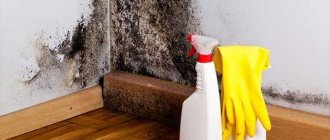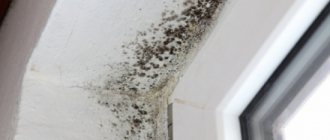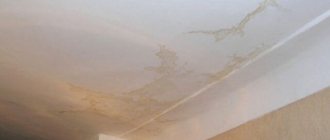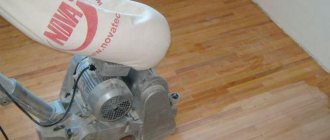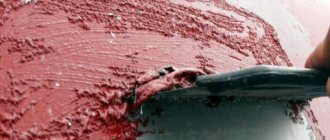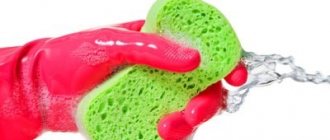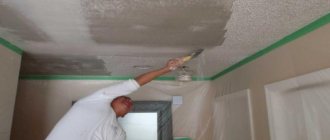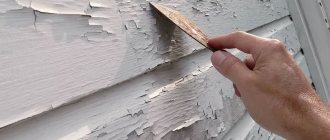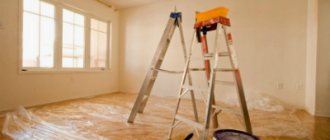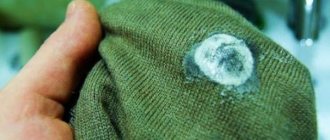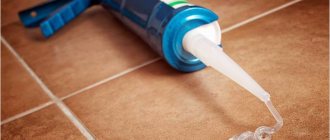Wood has been the main building material used for the construction of houses and other vital structures for many years. It is suitable for use in different climatic zones. The main advantage of building houses, bathhouses, and summer houses from this material is the cost-effectiveness and speed of construction. Despite its advantages, lumber has its disadvantages. The main one is the susceptibility of wood to rotting and fungus formation. Wood-shaving products absorb moisture well, as a result of which mold appears on the boards, and then on the walls of the house.
When faced with a problem, many people have no idea how to treat the wood so that the characteristic blackening does not occur. There are many ways to get rid of fungus, but before treating the material, you need to prepare and identify the causes of rot on the surface. In addition, they additionally check and regulate the operation of heating, water supply and other basic home supply systems.
Why does the board turn black?
In theory, all your subfloor boards should have been treated with bioprotection before installation.
Note that this does not prevent mold from forming on top of the boards. But if no bioprotection has been done at all, treatment needs to be carried out. Be sure to use a respirator and be extremely careful under the floor, staying as little in the underground space as possible. There are many reasons for the appearance of black fungus on boards:
- poor ventilation in the room;
- high humidity;
- sudden changes in temperature;
- condensation formation;
- low-quality wood;
- contamination of building materials by fungal colonies;
- prolonged contact with damp soil.
Why is black mold on boards dangerous? Black fungus is dangerous not only because of its rapid spread, but also because of its negative impact on people and animals that are forced to inhale the spores. Black mold on lumber that is used to build a house or for interior decoration of residential premises can lead to contamination of absolutely all surfaces. In this case, the damage can be so serious that complete dismantling of wooden structures will be required.
Ways to protect wood from rot and mold: how to treat it?
Contents
hide
1 Ways to protect wood from rot and mold: how to treat it? 1.1 Where is wood protection from rot and mold primarily needed?
1.2 How can you tell if mold and rot have appeared on a tree?
2 Protecting wood from rot, mold and moisture: methods of prevention 2.1 Creating conditions under which rot and mold do not appear 2.1.1 Video - lumber affected by white mold and fungi 2.1.1.1 Materials used in the article:
Wood is a common, easy to process and environmentally friendly material. It is used in various areas of construction: baths and houses are built from wood and used for interior and exterior decoration. Wood is also used to create furniture and various interior products (from photo frames to stairs).
Wood has a significant drawback: it is susceptible to rotting and does not tolerate moisture well. With increased humidity, fungus quickly appears on the tree, it begins to rot, losing both its appearance and its qualities. Let's take a closer look at the reasons for this phenomenon, and also look at ways to protect wood from rot and mold.
Of all building materials, wood is the most susceptible to mold and rot. The reasons are as follows:
- Wood is a natural, living material. It contains enough nutrients for the full growth and reproduction of the fungus.
- Natural materials are able to breathe and absorb moisture well. Moisture causes wood to rot and become moldy.
- Even well-dried wood still contains about 20% moisture, which is enough for mold to form. With proper processing, care and maintenance of wooden structures, there is no need to be afraid of mold and rot. But if the conditions are incorrect, then the fungus will definitely appear.
- Do not install wooden structures in the ground. In this case, it is almost impossible to protect them from moisture penetration (unless they are additionally covered with something on top).
- This material is not suitable for rooms with high humidity and poor ventilation. If you cannot do without wood in such rooms (for example, in bathhouses), they need to be properly looked after: ventilated, dried, warmed.
- Wood rots in underground rooms if they are not equipped with high-quality internal and external waterproofing and insulation. The reason is sudden temperature changes and condensation formation.
- Freezing of boards and logs also leads to increased humidity and, as a result, the formation of mold and rot.
In addition to the fact that mold loves to live on wooden products, it is precisely to them that it causes the greatest harm:
- the aesthetic appearance of materials is lost;
- strength is lost;
- shape may change;
- the destruction of the product is accelerated.
In addition, mold growing indoors on finishing materials causes irreparable harm to human health.
Where is wood protection from rot and mold primarily needed?
Wood protection from mold is needed always and everywhere. Especially if the room supports:
- high humidity;
- lack of sunlight;
- poor ventilation (insufficient amount of fresh air, poorly functioning exhaust hood, clogged ventilation shaft) or its absence;
- direct contact with the ground;
- sudden temperature changes.
The greatest attention should be paid to the protection of wooden structures in the following rooms:
- If direct contact of logs or boards with the ground is envisaged, maximum protection from moisture must be ensured. This is true for barns and chicken coops.
- It is common to find mold in the basement on wooden shelving and drawers. You can also often find mold in the basement. In general, underground buildings are a symbiosis of all the necessary conditions for the growth of mold colonies.
- Mold often appears in a bathhouse - if it is not properly arranged and cared for.
- Also, processing of wooden products is needed in unheated rooms: in sheds, garages, attics.
How to understand that mold and rot have appeared on a tree?
Rotting wood emits a specific smell. If upon entering the room you hear a musty, unpleasant smell of dampness, start looking for the “enemy”.
If mold is not detected and destroyed immediately, wooden products begin to darken, a wet coating appears on them, and they become “soft” in appearance. If you examine all wooden surfaces, you will find a coating of black, white, green or blue on them (may be in the form of spots or fluff).
Rotten wooden boards
If measures are not taken on time, rot appears in the wood, which quickly begins to destroy its structure.
A little about mold
Mold in a wooden house is the simplest microorganisms that very quickly unite into numerous colonies, which quickly become visible to the human eye.
If there are several types of mold - wood-staining, which destroys wood and causes harm to humans, and wood-destroying - which does not have a negative effect on people, but contributes to the rapid destruction of walls. In case of large lesions, the house is usually designated for demolition.
The most poisonous mold is yellow. It releases substances that, in some cases, lead to the formation of tumors.
Choice of impregnation
The most popular brands of impregnation include:
- "Tree healer" Impregnations of this brand can be used to treat a wide variety of wood species at any stage of damage. Impregnation is non-toxic, and therefore can be used not only for external, but also for internal work.
- "Biox." Impregnation helps protect the material from mold and does not disturb the texture and relief of the surface. This brand produces both colored and transparent protective compounds.
- "Biosept". It is distinguished by its versatility and can be used for finishing residential and commercial premises. Biosept contains the latest generation of biocides. The drug is environmentally friendly and resistant to moisture. The impregnation is resistant to washing off and other mechanical influences. Subsequent painting of the surface is possible.
- "Aquatex". This protective agent is especially suitable for treating lumber and wood products (windows, doors, stairs, etc.).
- "Pinotex". Antiseptic agents, paints and oils under this brand are applicable to all types of wood. Effectively prevents surface fading.
- "Elkon". Several specialized types of impregnations of this brand are produced. In particular, Elcon Aqua Bio is intended for freshly manufactured lumber. Elkon T is used for processing end parts. "Elkon Sauna" is used to protect surfaces in baths and saunas.
- Well-known Finnish - produces antiseptics of all varieties (covering, priming, glazing). Also popular are their oil paints for sawn, planed and rough surfaces.
- British is famous for its high-quality organic primers and antifungal protective compounds. Impregnations not only guarantee protection against fungus, but also protect the surface from damage from exposure to sunlight and moisture.
- German impregnations are characterized by deep penetration. At the same time, they do not interfere with the breathability and texture of the material.
How to get rid of mold on trees
First of all, wooden surfaces suffer from fungal infections, since organic substances are the most attractive and favorable environment for the development of mold. Under the influence of high humidity and heat, wood quickly loses its attractiveness, darkens and disappears.
Having seen the first manifestations of fungus, proceed with urgent methods of disinfection and its removal from surfaces in the house. To do this, you will need one of the following wood mold repellents:
- antiseptic substances;
- wood bleach;
- vinegar;
- baking soda;
- hydrogen peroxide;
- drying oil;
- glue;
- ammonia;
- borax;
- tea tree oil.
Vinegar, available in every kitchen, is a natural and relatively harmless disinfectant. To get the most effective results, use the substance as follows:
- Fill a spray bottle with concentrated acetic acid.
- Spray the liquids onto the fungus-affected areas.
- Clean the wood with a brush.
- Re-treat the surfaces and leave in this position for about an hour.
- Wipe the surface with a damp cloth.
Hydrogen peroxide is a medical solution that works well against mold spores and fungal infections. Buy the solution at any pharmacy and use it according to the following algorithm:
- Spread the 3% hydrogen peroxide solution evenly over the affected area of the wood.
- Leave the surface for 10 minutes for the necessary chemical reactions to occur.
- Remove all traces of mold using a stiff-bristled brush.
- Use a damp cloth to return the product to its attractive appearance.
This substance is perfect for use as a remedy for fungus on wood.
To achieve maximum cleaning efficiency, use baking soda in the following way:
- Wet a small piece of clean cloth with water.
- Dip the cloth in pre-soaked baking soda.
- Wipe the moldy area of wood with the substance.
- Remove any remaining substance from the wooden surface using a brush or clean cloth.
If fungus appears on a tree, it is best to use special products that are sold in household chemicals departments. The product must be sprayed onto the affected areas, and after an hour there will be no trace of the fungus left.
If desired, you can use folk remedies, namely copper sulfate and lime. The components are mixed and filled with water, and then applied to the wood. It is best to remove mold from wood promptly before it begins to spread.
Monitor the humidity level in your home
Fighting methods
In addition to knowing what products will help remove fungus from wood, you need to know what stages the processing of boards includes. Undoubtedly, it is best to work with a board at the stage of its manufacture (ideally, buy it at a sawmill) or purchase it from a well-equipped warehouse. In this case, the building material is simply dried and, if necessary, opened with special antiseptic compounds.
If building materials have already been used during the construction of the building, then first of all it is necessary to take care of normalizing the level of humidity in the room and the correct temperature conditions. Only in this case will household chemicals help cope with the problem. The next step is disinfection of the surface.
Experts recommend first using more gentle methods of influence - folk recipes, which include natural ingredients such as lime, soda, vinegar, etc.
And only after such treatment has not brought tangible results, one should move on to radical methods of struggle.
Black mold
If you don’t look closely, you might think that a black coating is just ingrained dirt that can be easily wiped off. However, these are colonies of microscopic fungi that are extremely dangerous to human health. They appear in places of high humidity - in swimming pools, bathrooms, bathrooms, kitchens.
This scourge affects air purifiers, starts up in washing machines and air conditioners, and clings between tiles. Fungal spores quickly enter the body through the respiratory tract, into the trachea, bronchi, and alveoli, leading to various diseases and necrosis. Growing rapidly and releasing large amounts of toxins, microorganisms can cause suffocation and even death.
Baking soda is an effective and simple remedy against fungus
The fungus can be removed with the help of special antiseptic preparations, which are presented in a large assortment on the shelves of building materials stores. It must be remembered that any chemicals used to remove fungus are poisonous. Therefore, it is necessary to work with them with extreme caution.
After removing the mold, the floor must be saturated with varnish or primer.
The best and time-tested remedy for fighting fungus is a special antiseptic primer. You can buy such a primer at building materials stores. It performs 2 important functions: it helps to defeat the fungus and protects against its occurrence in the future.
Antiseptic primer is easy to use and usually doesn't even require adding water. If the primer is undiluted, be sure to follow the instructions to get the right composition to effectively combat the fungus.
Before applying the primer, the affected surface is cleaned. If mold has penetrated deeply into a plastered wall, it is necessary to clean everything down to a clean layer. Sometimes you have to reach a brick or concrete slab. The primer is applied evenly onto a dry surface using a paint brush. After the primer has dried, you can glue wallpaper or apply paint.
Home remedies can also be of great help in fighting fungus. They are not as effective as antiseptic primers, but at the same time they are less toxic. Using ordinary bleach you can kill almost all types of mold. The active ingredient in bleach, sodium hypochlorite, kills the fungus and its spores. Using bleach you can clean floors, glass, and tiles in the bathroom, but some things become discolored and deteriorate when exposed to bleach.
If groundwater penetrates into the basement, you need to backfill the floor with stones and sand.
In addition, bleaches emit toxic and harsh fumes and corrode the skin of your hands. Before you begin removing fungus with bleach, you must make sure that the room is well ventilated. Be sure to wear rubber gloves to protect your hands. The affected surface should be treated with a mixture of 1 part bleach to 10 parts water.
We suggest you familiarize yourself with How to properly lay a vapor barrier on the floor
Ordinary vinegar can also destroy many common types of fungus. It has a distinctive odor, but does not emit harmful fumes like bleach. To get rid of fungus, vinegar should be applied to the affected surfaces using a spray bottle or wiped with a damp cloth.
Ammonia is also used to kill fungus. Like bleach, ammonia easily removes mold on non-porous hard surfaces such as glass or tile, but it is not suitable for removing mold from porous materials. To destroy fungus using ammonia, it must be mixed in equal parts with water and sprayed onto the infected area. The solution is left on the surface for several hours and then washed off.
The characteristic pungent odor of alcohol can cause a sore throat and headache. You cannot mix ammonia with bleach, because... this releases poisonous gas.
One way to avoid the appearance of fungus under the floor is to install a heating system.
Baking soda is also a very effective remedy for fighting fungus. It attacks mold and is known as a safe and natural household cleaner. Unlike other products containing harsh chemicals, baking soda will not harm people or animals. Dissolve a teaspoon of soda in a glass of water and spray the affected surfaces with this solution.
You can get rid of fungus using a variety of means, but this is only half the solution to the problem. The second half is the need to ensure dryness and regular ventilation of the room where the fungus was found in order to prevent its recurrence.
Any work related to the fight against fungus can harm your health. Mold spores can land on your skin and inhale. This is a very serious problem that can lead to various health problems.
From the video you will learn how to effectively combat mold on wood.
There are many methods, natural and synthetic products.
Folk remedies
Traditional methods against wood damage are gentle and effective, but they do not protect the material for long.
Medium 1: resin
Resin heated before application helps against fungal spores.
Pros:
- effective,
- safe,
- cheap.
Minuses:
- The surface remains sticky.
- The resin is viscous, difficult to apply, you need to stretch it.
Silicate glue diluted to a state of medium ductility is used. It is used to treat the surfaces of wooden products and coatings 1–2 times.
This is a safe hypoallergenic composition. Has a short-term effect, not suitable for some types of mold.
A 5% solution of potassium dichromate and a 5% sulfuric acid concentrate are mixed in equal proportions.
The resulting solution is used to treat the boards and soil adjacent to the structures. The method is effective, but dangerous for the soil.
To get rid of an existing outbreak, sprinkle the area with soda and spray with 9 or 6% acetic acid.
Prepare a solution from 5 liters of hot boiled water, 1 kg of table salt, 50 g of boric acid. Mix thoroughly and process the wood.
Take 100 g of dry matter and dilute it in 10 liters of water. The boards are treated with the solution, then dried and used for construction.
Remedy 7: whiteness
Chlorine bleach works well to remove fungus, but keep in mind that the liquid lightens the wood.
In baths and saunas, it is possible to remove mushrooms only using folk remedies. To cure the affected area, clean the boards with soda, pour vinegar on them, and wait for the reaction to complete. Then wash off the reagents with water and cover the area with tea tree oil diluted in warm water.
Folk remedies are not always effective and safe. They are used when there are no special drugs at hand, and the problem needs to be solved quickly.
A set of works that makes it possible to remove mold and mildew in wooden houses with a high degree of probability includes the following operations:
- Cleaning wooden surfaces from detected pests using a variety of mechanical means, starting with scrapers and sandpaper, and ending with a grinder with an abrasive attachment;
- Thorough treatment of infected areas, and, if there is a sufficient amount of antifungal composition, of all wooden surfaces;
- Removal of wooden structures damaged by fungus or their individual places.
Naturally, it is not enough to simply treat a wooden house against fungus. As noted above, it is extremely important to install an effective ventilation system, as well as, where necessary, high-quality waterproofing. Only in this way will the main cause of the appearance of fungus, rot and harmful microorganisms be eliminated - high humidity.
In order to effectively remove fungus in the basement of a wooden house or on other structural elements of a building, various means can be used. The most popular today are several formulations. Firstly, the saber, which is made on the basis of sulfur, is deservedly among the most effective.
Buying this drug is quite simple, as it is sold in most household supply and building materials stores. It is extremely harmful and dangerous for humans, therefore it is used only in closed and temporarily isolated rooms, which are allowed to be entered after 10-12 hours after lighting the checker.
Secondly, chlorine-containing compounds, for example, bleach, are quite in demand. When working with them, the use of protective clothing is required, including the mandatory presence of a respirator, since a highly concentrated solution is most effective. After treatment, the room should be thoroughly ventilated.
Thirdly, owners of wooden houses often choose to use various antiseptic compounds. This is explained by the fact that modern drugs, as a rule, have a complex effect and are able to effectively fight, including mold and mildew.
Special antifungal primers are also noticeably popular. They are very effective and not only remove areas of fungus and mold, but also prevent the reappearance of pests. The composition is applied in several layers using a regular brush. Before using such primers, you should carefully prepare the base, cleaning it to uncontaminated areas of the wood.
In addition, a folk remedy is often used, which is a solution of various types of sulfate - copper or iron. The choice of a specific option depends on the preferences of the homeowner. However, in any case, when using, you must carefully follow the instructions for use.
If the fungus has taken over a large area, the wooden floor will have to be dismantled
It is much easier to get rid of a problem at the first sign of its appearance. There are various ways to combat mold under the floor in a private home. There are commercially available chemicals to remove fungus, but you can use traditional methods.
To completely get rid of the problem, it is recommended to follow the following instructions:
- Clean things are removed from the premises, and contaminated household items are thrown away or thoroughly disinfected.
- The affected floor covering is dismantled. If mold appears on part of the floor, only remove it. If the fungus has affected a large area in the room, complete dismantling of the coating will be necessary.
- The damaged surface is treated with antiseptic agents.
- The top layer of soil in the underground is removed.
- The floor is covered with crushed stone and lime.
- Logs are laid, and treated wooden boards are mounted above them.
We invite you to familiarize yourself with the stove-fireplace for a bath: wood-burning with large glass, do-it-yourself stove in one photo, wood-burning how to build
Preservation and application of antiseptic
Treatment of spores can be carried out using several methods. The most effective of them is conservation. This means that the fungus and the materials on which it lives will be coated with a special, long-lasting fungicidal composition. Gradually, without oxygen access inside, the mycelium will die.
Treatment for fungus and mold may be different. The infection is exposed to a steam bath or a special diffusion impregnation is done. An alternative to this is applying an antiseptic solution; the procedure can be done at home, without the help of professionals. On the shelves of hardware stores there are both expensive and cheap mixtures, but in essence they are the same.
The prepared product is applied to the affected areas on the wood with a regular roller or wide paint brush. The choice of antiseptics is wide and varied. Moreover, modern formulations do not have a strong odor and are therefore safe for use. They do not contain toxic chemical compounds that can harm humans if inhaled.
Wood antiseptic is the best remedy for combating microscopic fungi. This group includes water-repellent, water-soluble, combined and oil-based substances, each of which is suitable in each individual case and is therefore selected individually.
How to get rid of mold on walls
Mold on wood floors appears as black spots
One of the main reasons for the formation of mold is considered to be high indoor humidity. Therefore, it is important to maintain the working condition of sewer pipes and drains. Before removing the fungus, you need to find out the reasons for its formation, and if they are related to the water supply system, carry out repair work and troubleshoot problems.
Mold often appears in rooms with poorly waterproofed basements. The fungus settles in dark, warm rooms away from direct sunlight.
The appearance of mold is caused by improper design of the ventilation system, which disrupts air circulation. Microspores are afraid of frequent ventilation, so they are usually found in enclosed spaces. Mold appears when waterproofing at seams and joints is of poor quality, or when it is completely absent.
To prevent the formation of mold, you need to get rid of high humidity in the room.
Removing fungus from the floor of a house or apartment is more difficult than preventing its occurrence. It is recommended to periodically treat wooden boards with antiseptic compounds. In this case, it is necessary to apply the mixture not only to the floor, but also to the walls, as well as the area under the baseboard. Pay special attention to the joints.
Mold often appears in rooms where there are many moisture-loving houseplants. To reduce the risk, you should create a comfortable microclimate in your home. The premises must be well ventilated and heated. Fungus rarely forms where there is normal waterproofing and air ventilation.
For preventive treatment of wood, compositions based on sodium fluoride or sodium fluoride are used. Preparations with ammonium or zinc chloride are effective. It is recommended to periodically treat floors and other wooden surfaces with solutions for prevention.
Mold on a wooden floor can appear due to various reasons, but the main ones are dampness, poor waterproofing and poor air circulation. Harmful microorganisms should be gotten rid of at the first sign.
When mold and mildew appear in a home, not only wood surfaces, but also human health are negatively affected. Therefore, if such a problem is identified, you should immediately move on to solving it. Spores enter the human body by air, causing various diseases of the respiratory tract, skin, and even lead to the development of bronchial asthma.
Children and adults with weak immune systems are susceptible to the negative effects of mold. It can cause nausea, migraines and loss of energy.
Mold spores are constantly in the air. They can wait a long time for the emergence of a favorable environment and a suitable surface for settling and beginning to reproduce. Wet wood is the best conditions for the development of fungus. It takes root at lightning speed on the surface, sprouting with the thinnest threads and forming whole foci of brown-black color. If measures are not immediately taken to remove them, mold will soon cover all wooden surfaces in the house, making it uninhabitable.
From the above it follows that the main cause of mold is high humidity. As for the ambient temperature, many types of this “disease” of the wood surface can exist and develop at 0 degrees and sub-zero temperatures. This is why we can often see basement walls covered with black stains and emitting a stench even in the winter season.
Another reason contributing to the appearance of fungus is improperly organized insulation and ventilation of rooms, as a result of which condensation accumulates on the walls. You can notice this quickly - by fogged windows, where the accumulation of steam is better visible.
Normal humidity is 70-80 percent. If this indicator is higher, due to excessively darkened rooms, an abundance of plants, frequent washing or other reasons, the liquid concentrates in certain places and leads to the formation of fungus.
Simply removing mold from the walls is not enough - the results will not last long and the problem will soon return. The correct technology for removing mold is to first eliminate its cause: waterproof the basement, ensure effective ventilation, allocate funds for insulation and create an optimal heating system.
One of the main points when building a house, which specialists always pay attention to, is the mandatory coating of the surface of the wood used in construction with special antiseptic substances that prevent the appearance of fungal formations. Walls should be treated with similar products once every certain period, usually indicated on the packaging. To start using drugs that have antifungal effects, you first need to:
- Sand problem surfaces using sandpaper or using a grinder.
- If possible, replace the affected part altogether.
- If the wood is damp, it must be dried by additional heating or ventilation of the room.
- Then, the product is applied to the surface with a brush or roller, penetrating deep into the timber and destroying the pores of mold.
- After some time, it is recommended to repeat the procedure.
Please note that along with other products, preventive liquids are sold in stores - they will not suit you if you need to get rid of fungus. Carefully read the instructions for use and clearly explain to the seller what is required, otherwise you risk buying an ineffective product, wasting time in the fight against mold in a wooden house and wasting money.
It is also better to treat not only areas with mold with mixtures, but entire walls.
1 how to get rid of mold in a wooden house
2 Mold under the floor (in the basement, in the underground)… How to lime?
Before you start fighting fungus in a wooden house, you need to find out the reasons for its appearance, determine the boundaries of its spread, and then move on to choosing a composition for treatment. The most common types of this pest found in buildings made of logs or timber are:
- White house fungus. It develops most quickly, covering a large area with mycelium, constantly increasing it. The best conditions for emergence are formed, as a rule, underground. Also often fungus is found under the floor or in the basement;
- Rotting fungi. There are several types that differ in color and appearance - white brown and bacterial. They most often appear near places with high humidity, for example, near water pipes, although dry rot also occurs;
- Blue fungi. A very dangerous pest that can penetrate wood, destroying the varnish or paint coating. Despite the fact that they do not cause serious consequences for the strength and integrity of the tree, they often act as a harbinger of the appearance of more dangerous types of fungus. In addition, they give the surface of logs and beams an extremely unpleasant bluish tint;
- Actinomycetes. They are a cross between algae and fungi. They have an extremely destructive effect on wood, quickly reducing its strength;
- Mold fungus. A universal pest that can exist not only on wood, but also on concrete, fabrics, stone and even ceramic tiles. They have spores that are extremely harmful to humans; in addition, they give contaminated surfaces of building structures an extremely unpleasant appearance.
Most often, fungus appears in the subfloor of a wooden house and its other structures for one reason - due to increased humidity levels. Therefore, it is quite logical to begin the fight against this extremely harmful phenomenon by creating an effective ventilation system that can ensure rapid and effective removal of moisture from the premises of the building.
Identifying different types of fungus is quite simple. Among its typical manifestations are the following: a sharp and damp smell, stains and darkening on wooden surfaces located in different places, wet areas in the corners of the building, on the floor or walls, etc. It should be noted that removing the fungus is not as easy as it might seem at first glance.
We invite you to familiarize yourself with decorating walls with plasterboard in a wooden house with your own hands: video
Eliminating fungus from a wooden surface is not that difficult. To do this, you must follow the instructions. There is no need to rush - and then the result will please any housewife. When choosing a method to destroy fungus, do not forget about safety. That is why it is best to choose a method that can be used at home.
To get rid of mold at home without much effort, just use regular whitewash. You should moisten the sponge with white, and then carefully wipe the wooden surfaces. Mold removal will begin in approximately 10 minutes.
It is best to carry out the procedure with rubber gloves. In addition, such a remedy can be used as a prophylactic agent.
Every housewife has table vinegar in her kitchen. This product easily eliminates mold on wood. Apply vinegar to a sponge and then thoroughly rub into the fungus. After this, it is best not to touch the walls for an hour. After the specified time, the surface of the walls is wiped with warm water.
The basement, which is under the floor, is the main place where mold appears. That is why it is urgent to treat wooden structures to remove mold. Most often, professionals use special destruction solutions that can be prepared at home.
The diverse and dangerous world of mold
The first signal that there is mold in the house is a change in the color of wooden surfaces, the appearance of characteristic blue, brown, pink and whitish spots, gray stains and a moistened surface.
Some fungi do not destroy the texture and do not penetrate deep into the wood, but they spoil the appearance of wooden wall cladding, floorboards, and ceiling trim. Not only in country houses built from rounded logs or timber, but also in city apartments with a poorly adjusted ventilation system or drafts, mold appears. For example, on the lining, which is often used to decorate a balcony or loggia, unpleasant dark spots may appear.
Colonies of black mold appear on boards much less often than on stone, brick or tile grout, and blue mold is a frequent guest in houses made of timber.
If during the construction of a house the timber or log was not treated with antiseptic impregnation, pale ink stains of mold, called “blue”, will soon appear on the wooden surface.
Fungi like the very common blue fungus completely change the color of wood. They feed on protein, starch, sugar and grow quite quickly - a spot can double in size in just 10 days. But for this, one condition is necessary - the moisture content of the wood is higher than normal.
Blue is not believed to affect strength characteristics, so spore-contaminated timber and lumber are often tested for suitability, and mold may be present in a batch of lumber intended for renovation work.
The most dangerous fungus for wood is putrefactive fungus. It feeds on the fibers of the material, breaking them down with secreted enzymes. First, bright brown spots appear on the surface of boards and logs, and after a few weeks or months the wooden elements become unusable.
At the initial stage, you can still get rid of the fungus by cutting and thoroughly polishing the surface (if possible), but if the mold penetrates deep into the board or log, you can no longer save it
Sometimes the process of development of the hearth occurs secretly: several subtle stains appear on the upper part, but active destruction occurs inside. “Sick” parts of the cladding or frame can be recognized by a dull knock. A durable-looking timber, affected by rot, breaks when pressed.
Mold is harmful not only to the wood itself, but also to people who inhale air contaminated with spores. If there are allergy sufferers in the house, they will always feel unwell when outbreaks occur. Small fungi are also dangerous for healthy people - they can provoke the occurrence or exacerbation of various diseases of the respiratory system.
Image gallery
Photo from
If blue mold appears on a frame that has been left to shrink, it is better to immediately disassemble it and replace the damaged crowns
Mold colonies appear not only due to failure to carry out antiseptic treatment, but also due to violation of building rules, in particular, in the absence of ventilation holes
At the installation points of fasteners that have not been galvanized, mold appears literally in the first months after the construction of the house
Blue mold spreads at almost cosmic speed in bathhouses and bathrooms if they are not built according to the rules and problem areas are not treated with a water-repellent agent.
The appearance of blue mold on a new log house
Result of lack of ventilation
The result of using non-galvanized fasteners
Lack of waterproofing in baths and toilets
The most vulnerable and susceptible to mold in a wooden house is the bathroom or combined toilet. The shower room suffers in the same way, even if the box is perfectly sealed and does not allow drops of water to pass through.
Therefore, when installing hygienic rooms in buildings made of timber or logs, it is imperative to follow the technologies for their organization and use protective antiseptic agents.
Causes of fungus on wood
To eliminate mold, you can use specially developed antifungal compounds, which are sold in every hardware store, among household chemicals.
Removing fungal infections should begin by removing spores from the most affected areas of the product, namely by stripping them. This procedure is carried out as follows:
- Clean the fungus on the wood using available means and tools - a wire brush, knife, chisel, etc.
- Dispose of the removed wood particles using a fire, which will not allow the spores to further develop and infect the living space.
- Wash the cleaned area of the wooden surface with a soapy solution.
To prevent the reappearance of surfaces affected by fungus, it is necessary not only to clean the affected areas, but also to destroy the spores present in the room. You can do this as follows:
- Purchase wood antiseptic from a specialized store.
- Prepare the current solution according to the proportions and instructions specified by the manufacturer.
- Treat not only the affected area, but also a specific area around it.
It doesn’t matter where exactly the mold appears: on various cutting boards, on plywood, etc. A material such as wood can be freed from fungus if the necessary measures are taken at the initial stage, before the mold has yet grown and completely penetrated the wooden products. Removing fungus, for example, in a basement or chicken coop, in this case, includes several key points:
- the affected area must initially be thoroughly cleaned - you can use a spatula or brush;
- soak the products with an antiseptic or other protective agent (it is better to choose a deep penetration product);
- A fixative is applied on top.
By adhering to certain rules for caring for materials such as wood and knowing how to promptly remove mold, you can significantly extend the life of wooden furniture.
Conclusions and useful video on the topic
The fight against mold must begin immediately after its discovery, in which case you will save not only your home, but also your health. Moreover, comprehensive measures to remove the fungus must be taken, including eliminating the causes of its occurrence. This is the only way to get rid of this problem once and for all.
You can get additional useful information on the topic discussed above from the video in this article.
Informative videos will help you choose a wood mold protectant and teach you how to use it.
You can protect wooden boards, logs or facing elements from mold yourself, but taking into account the recommendations of the manufacturer of special products and compliance with safety standards.
If you choose the right impregnation or decorative protection, the wood surface will retain its original appearance for a long time, and proper thermal insulation and effective ventilation will create conditions under which mold will never settle in your home.
Do you know an effective way to get rid of mold in addition to those we have given? Would you like to share your own experience in combating this very persistent biological phenomenon or would you like to ask a question? Please comment in the block below.
How to prevent mold from reoccurring
To prevent mold from settling on the walls of your home again, you should follow certain rules:
- ventilate the room more often;
- do not place furniture close to the wall, leave at least a minimum gap to ensure air passage;
- the drainage system should be organized in such a way that melt and rainwater do not flow down the walls;
- the façade of the house is also hydrophobic;
- use preventive measures;
- leave a small distance between the wall and thermal insulation materials.
Please note that if your neighbors’ houses are infected with mold or have noticeable cracks, the problem can quickly spread to you. Warn her by following all the above rules.
Dealing with mold before construction
To prevent the tree from subsequently bringing mold into the house, you need to know a few rules.
Rule one - honest seller
When choosing a supplier of log cabins, boards or other lumber, ask the seller how long the wood material lasted after cutting. The fact is that wood stores different amounts of moisture depending on the time of year. In winter, you can send logs from the harvesting site to the construction site without treatment (which is why many people prefer winter wood), but in summer it is extremely important that the treated surface of the log is covered with at least a transport antiseptic. This, of course, does not eliminate the need for surface treatment after construction is completed.
From the point of view of protection against mold, it is worth allowing a house or bathhouse built from raw logs to settle before cutting in doors and windows, as well as starting finishing. After about a year of standing under the roof, the tree will dry out enough to be more resistant to mold growth.
Rule two - do not build a house next to large trees
This will prevent your home from drying out improperly. Strong shading and a humid climate contribute to destructive processes occurring inside the wood. If this is your case, it is better to pay attention to dried building materials, such as profiled or laminated veneer lumber.
Rule three - concrete and drainage
To build a high-quality house made of wood, remember that the structure should be placed on concrete. Also, do not forget about organizing a proper drainage system with blind areas.

